Vespa Pre 1979 Large Frame
Engine Work
|
|
Oil Mixer (Autolube)
The Vespa 150 Super was the first Vespa
to have a separate two stroke oil tank with a mixer device to correctly
mix oil and gasoline in the engine intake. For the first time Vespa
owners could put in a quart of oil through one filler cap, and then
fill up with typical gasoline in the main tank, with no fussy mixing at
the station. There were two systems used over the run of the Vespa
engine. The first system is noted in this section and was used on any
bike with autolube up to the P series models.
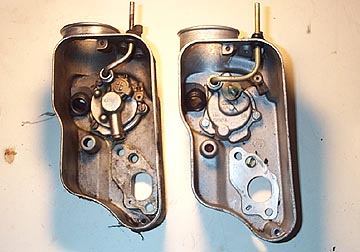
The system is driven off a small gear on
the crank which powers a small oil pump by a worm drive. The pump is
located in the carb box just forward of where the carb should be. The
carb boxes above are of the two different systems. On the left is the
older system used up to the Rally 200. On the right is the P series
system still in use today. Both systems have an arm which connects to
the throttle linkage so the amount of oil pumped is in relation to the
engine speed from the drive and the throttle position.
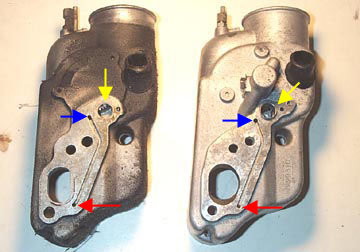
Above is a shot of the underside of the
carb boxes for both systems. Again, the older system is on the left and
the newer system is on the right. Both use the idea of a pump with a
small groove in the bottom of the carb box to get the oil feed from the
pump to the carb. The drive hole from the worm gear is marked with a
yellow arrow, the oil pumped from the pump comes out of the hole marked
with a blue arrow, and then moves down the groove to the red hole where
it enters the carb.
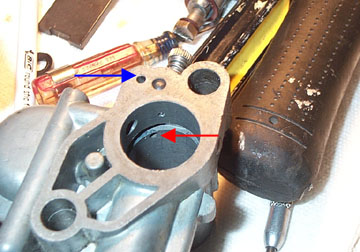
Once it comes through the carb box it
goes into the carb where the blue arrow is shown, and is combined with
the gasoline when it comes out of the hole marked with a red arrow,
above the throttle slide.
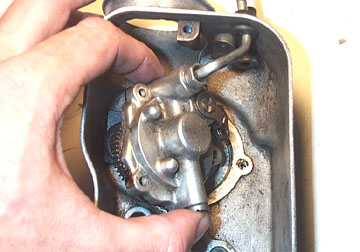
There is really not much to service in
the pump other than replacing the gasket and making sure the pathways
are clear. To service the oil pump in the older system, remove the
three flathead screws that hold the pump body to the carb box. Once
these are removed you can carefully twist the pump out of the box.....
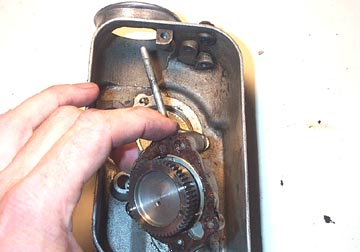
...and slide the oil intake line through
the carb box body. Discard the old gasket as it should be replaced
whenever the pump is removed.
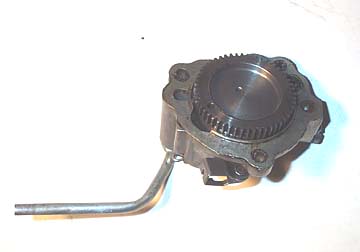
Once the pump body is out of the box,
have a careful look at it to see how it works. It is a little
complicated, but once you understand it, it starts to make more sense.
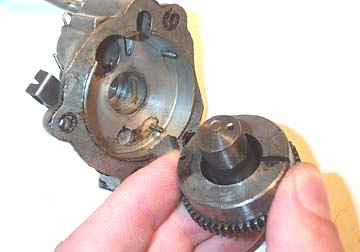
The central drive gear can be removed by
pulling it out from the pump body. Pay particular attention to how the
throttle arm linkage connects to the circular piece above the gear, and
how the slot in the gear aligns with the small dowel in the pump body.
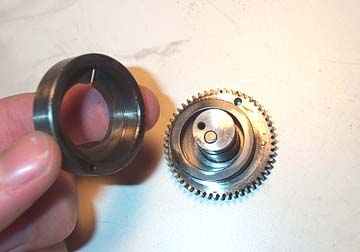
The circular piece can also be removed from the drive gear to
expose another circular piece which slides on a dowel to the main drive
gear.
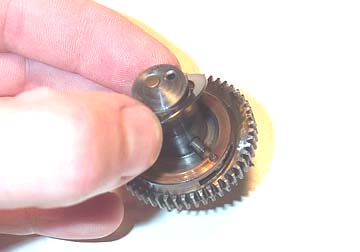
...and finally a small bushing between the two. I took this
apart to see how it worked more than anything (I'm like that). For
servicing make sure all the parts are clean, and the passageways in the
carb box are also clean.
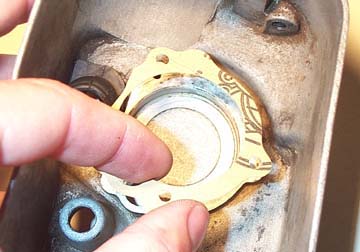
When you replace the pump back in the carb body always use a
new gasket between them.
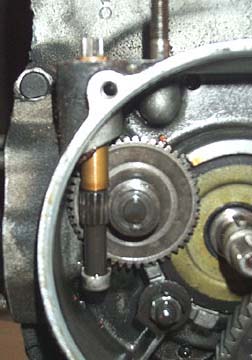
The drive itself is the only other part that needs to be
checked. It is turned by a small gear that is on the end of the crank
between the clutch and the oil seal. It is held on the shaft by the
woodruff key in the crank end. In the picture above it has been
removed. A second drive gear turns on a small shaft embedded in the
casing, which ultimately tuns a vertical shaft via a worm gear. Check
that all the teeth in all the gears are in good condition. Spin the
gears to make sure the oil drive vertical shaft turns. It will turn
very slowly.
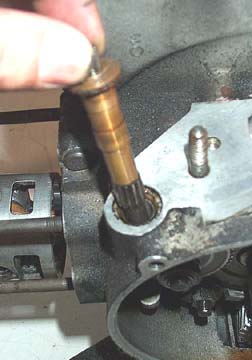
If the shaft needs to be replaced it can simply be lifted out
of the casing. Once the oil pump is back together you can test it by
this simple test. First, connect the oil line from your bike to the
carb box oil intake. Then, take the vertical shaft drive out of the
casings and very carefully and loosely chuck it up in a variable speed
drill. Insert the end of it into the underside of the carb and slowly
rotate it in the counter clockwise direction. On the underside of the
carb, oil should start to dribble out of the hole next to the drive
hole (in the groove).
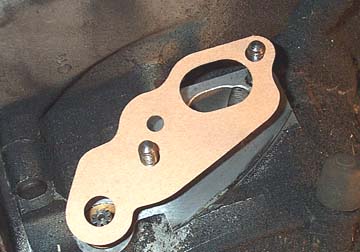
When you install the carb box, use a new gasket between the
casing and the box. There are a bunch of different gaskets out there so
make sure you have one that has a hole for the mixer drive gear.
Make sure the gear engages into the oil pump hole when you
place the box down on the casing.
Finally, make sure the gasket you use between the carb has the
hole punched out as shown above. If not the oil will make it all the
way from the pump to the underside of the carb box and then hit a dead
end. The hole in the gasket must align with the oil hole in the carb
box for the oil to make its way into the engine.
|
|
|